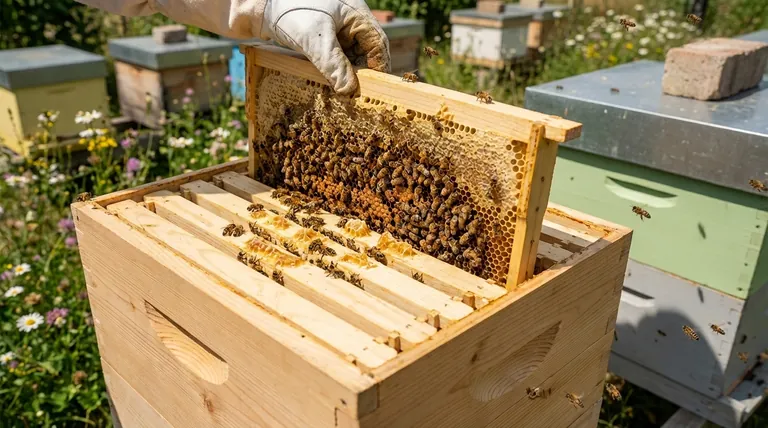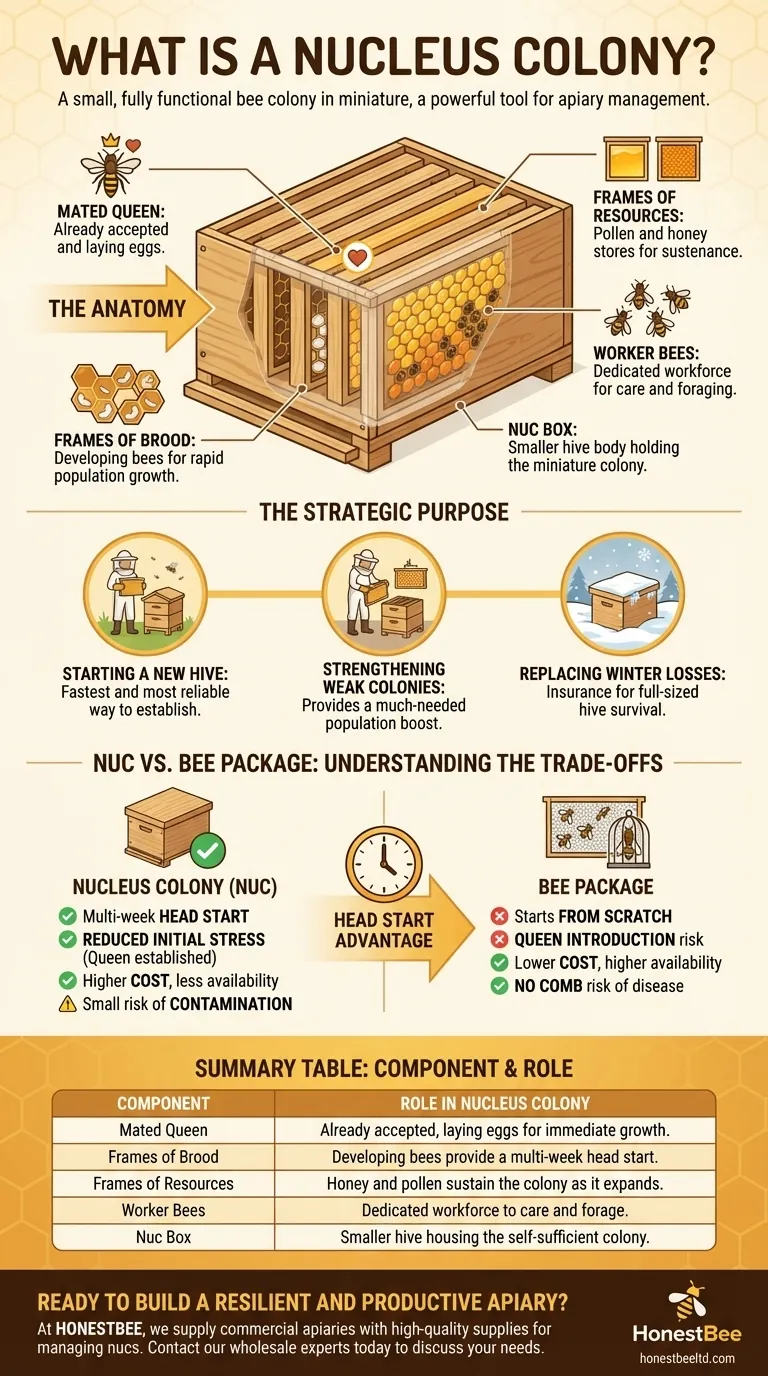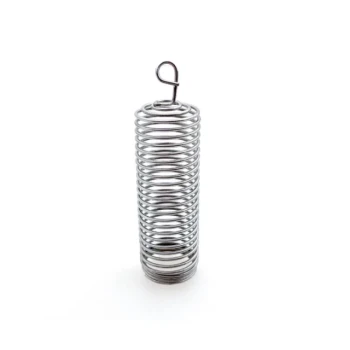In essence, a nucleus colony is a small, fully functional bee colony in miniature. It contains a mated, laying queen, worker bees, and several frames of honeycomb that include developing bees (brood) and food stores like honey and pollen, all housed in a smaller-than-standard hive box.
A nucleus colony, or "nuc," is fundamentally different from a package of bees. Its key advantage is the inclusion of frames with brood, which gives the new hive a significant head start in population growth and establishment.

The Anatomy of a Nucleus Colony
A nuc is carefully constructed to be a balanced, self-sufficient unit. Each component serves a critical function that ensures the colony can grow into a full-sized, productive hive.
The Mated Queen
The queen is the heart of the colony. In a nuc, she is already mated, accepted by the worker bees, and actively laying eggs, eliminating the uncertainty and delay that can come with introducing a new queen.
Frames of Brood
This is the most valuable component. A typical five-frame nuc includes two or three frames containing brood, which are the developing eggs, larvae, and pupae. This pre-existing next generation of bees ensures rapid population growth.
Frames of Resources
The remaining frames are dedicated to food stores. These contain pollen (protein for feeding young bees) and honey or nectar (carbohydrates for energy). These resources are vital for sustaining the colony as it expands.
The Worker Bees
A nuc contains a few pounds of worker bees. Their jobs are to forage for new resources, care for the queen and brood, and defend the small colony until its population increases.
The Nuc Box
This entire miniature colony is housed in a "nuc box," which is simply a small hive body designed to hold fewer frames (typically five) than a standard hive.
The Strategic Purpose of a Nuc
Beekeepers use nucleus colonies for far more than just starting a new hive. They are a versatile tool for managing a healthy and expanding apiary.
Starting a New Hive
For a new beekeeper, a nuc is the fastest and most reliable way to establish a colony. Because it is already a functioning social unit, it builds up much more quickly than a package of bees.
Replacing Winter Losses
Many beekeepers create or purchase nucs in the summer and overwinter them. These small but viable colonies serve as insurance, ready to replace any full-sized hives that don't survive the winter.
Strengthening Weak Colonies
A nuc can be used as "spare parts." A beekeeper can take a frame of capped brood from a strong nuc and give it to a weaker hive, providing a much-needed population boost.
Understanding the Trade-offs: Nuc vs. Bee Package
While a nuc is an excellent resource, it's important to understand how it compares to the other common method of starting a hive: a bee package.
The Head Start Advantage
A nuc begins with a laying queen and frames of developing bees, giving it a multi-week head start on a bee package, which is essentially just a container of bees and a caged queen that must start from scratch.
Reduced Initial Stress
The queen in a nuc is already established. A package requires the beekeeper to introduce the queen, a delicate process where there is a risk the bees may not accept her.
Cost and Availability
Nucs are almost always more expensive than bee packages because you are buying an established colony with drawn comb and brood. They also tend to be less available, especially early in the season.
Risk of Contamination
Because a nuc includes frames of comb from another hive, it carries a small but real risk of transferring diseases or pests. Bee packages, having no comb, largely mitigate this specific risk.
Making the Right Choice for Your Apiary
Choosing between a nucleus colony and other methods depends entirely on your specific goals and experience level.
- If your primary focus is a successful start as a new beekeeper: A nuc is the recommended choice, as it is a pre-established colony that significantly reduces early-stage complications.
- If your primary focus is rapid expansion or honey production: A nuc provides the fastest possible path to a strong, productive hive ready for the season's nectar flow.
- If your primary focus is boosting or supporting an existing apiary: A nuc serves as the perfect resource for strengthening weak hives or replacing queens.
Ultimately, understanding the function of a nucleus colony is a fundamental step toward managing a resilient and productive apiary.
Summary Table:
| Component | Role in the Nucleus Colony |
|---|---|
| Mated Queen | Already accepted and laying eggs, ensuring immediate colony growth. |
| Frames of Brood | Developing bees (eggs, larvae, pupae) provide a multi-week head start. |
| Frames of Resources | Honey and pollen stores sustain the colony as it expands. |
| Worker Bees | A dedicated workforce to care for the colony and forage for new resources. |
| Nuc Box | A smaller hive body that houses the entire miniature, self-sufficient colony. |
Ready to build a resilient and productive apiary?
Starting with a strong nucleus colony is the most reliable path to success. At HONESTBEE, we supply commercial apiaries and beekeeping equipment distributors with the high-quality supplies and equipment needed to manage nucs effectively. From durable nuc boxes to essential hive tools, we support your operation's growth and honey production goals.
Contact our wholesale experts today to discuss your apiary's needs and discover how HONESTBEE can be your trusted partner in beekeeping success.
Visual Guide

Related Products
- 5 Frame Wooden Nuc Box for Beekeeping
- HONESTBEE Professional Entrance Bee Feeder Hive Nutrition Solution
- No Grafting Queen Rearing Kit: System for Royal Jelly Production and Queen Rearing
- Professional Galvanized Hive Strap with Secure Locking Buckle for Beekeeping
- Jenter Queen Rearing Kit Complete Set for Bee Breeding
People Also Ask
- What frames should be moved into the queenless hive when requeening with a nuc? Ensure a Successful Queen Introduction
- How should the nuc be installed in the apiary? Ensure Colony Success from Day One
- What is the purpose of having a nuc in beekeeping? Build a Resilient & Productive Apiary
- What is a common feature of many 5-frame nuc boxes? The Integrated Feeder for Efficient Colony Growth
- What are the benefits of moving nuclei around the apiary? Master Strategic Hive Management



















